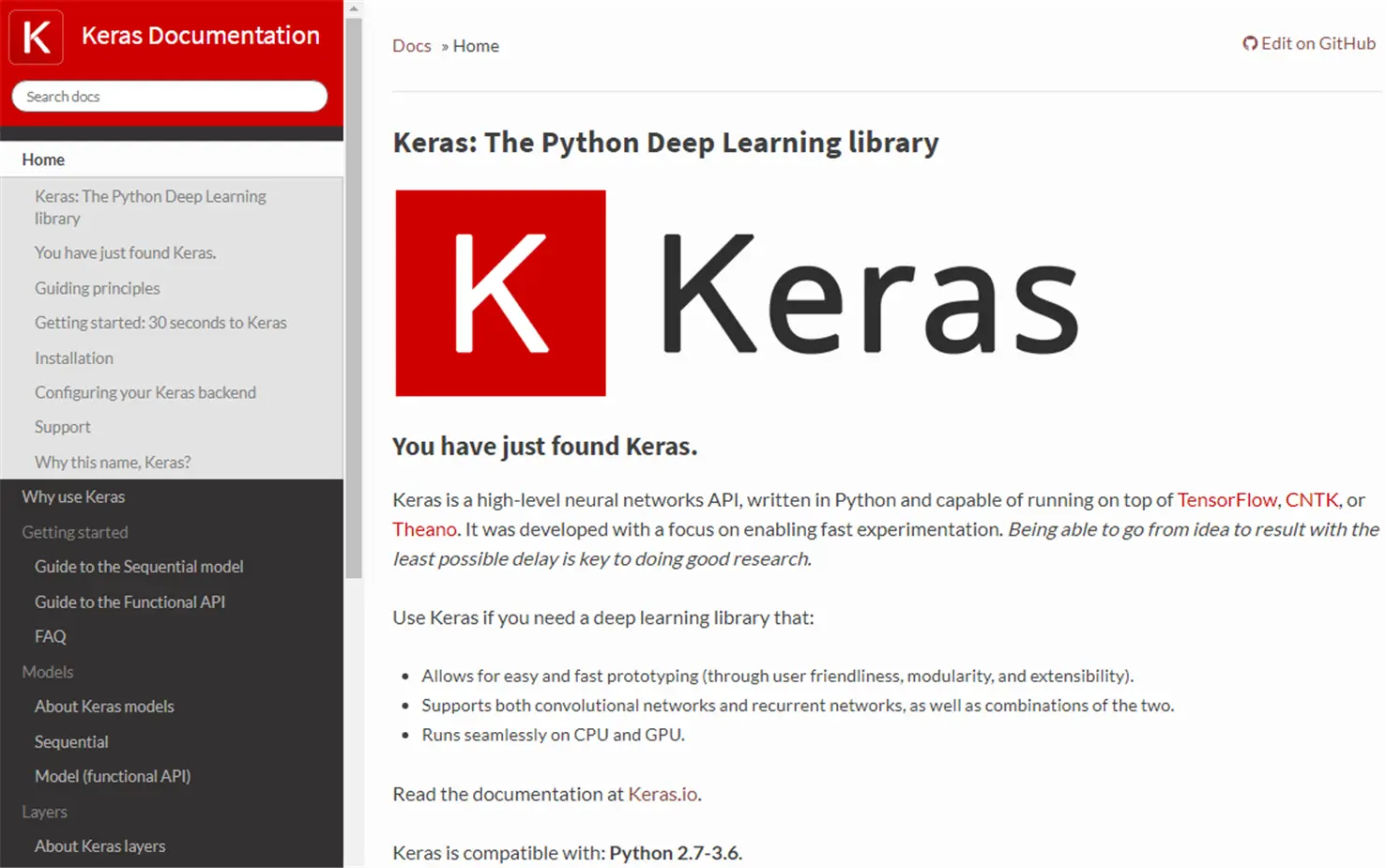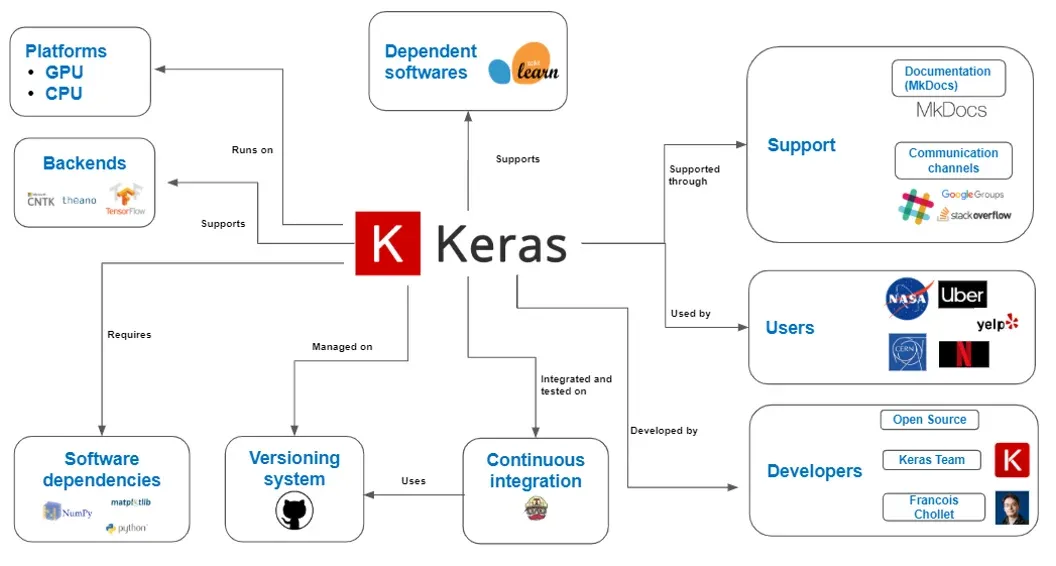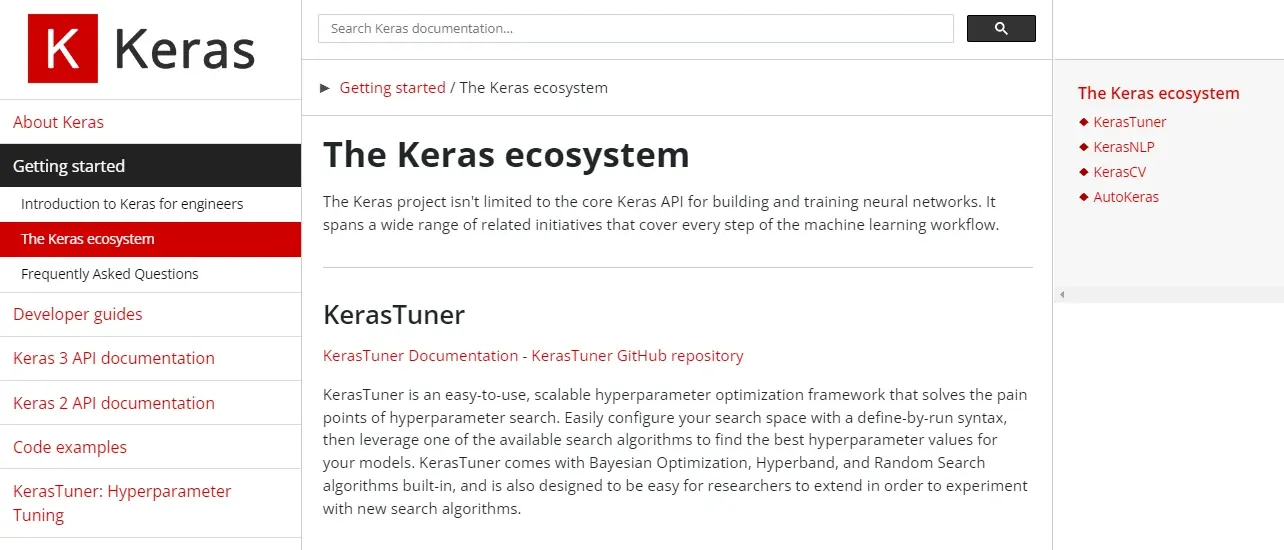Keras simplifies complex deep learning into easy Python programs, making it the top choice for machine learning. It has benefits, from working on powerful systems like TPUs to easy-to-use libraries for quick model testing.
Keras is a free tool for creating and training neural networks. It uses Python and can work with TensorFlow, Theano, and CNTK.
It makes building deep learning models easier by giving a simple interface. It hides the tricky parts, letting developers concentrate on designing and testing network setups. With Keras, you can define layers, connections, and functions with just a few lines of code.
According to a 2023 survey by Kaggle, Keras is the most popular deep learning framework among machine learning practitioners, with over 60% of respondents indicating that they use it regularly.
Let's explore nine aspects that boost development, simplify use, and improve models.
See how fast it is, adaptable to various needs, supported by a great community, and customizable.
Keras is the go-to for everyone, from big companies to beginners, making experiments easier and helping achieve top-notch AI in computer vision, language processing, and predictions.
Ease of Use

Keras is known for its ease of use, thanks to its simple and intuitive API. Let's break down the key aspects of Keras that contribute to its user-friendly nature:
- Simple Interface: Keras offers a clear and easy way to build and train neural networks. It's designed to be user-friendly perfect for both beginners and experts. The structure is logical and simple, making it effortless to set up your models.
- Easy Model Construction: With Keras, making neural networks is simple. It uses a modular method where you can pick from various ready-to-use layers like dense, convolutional, or recurrent, and stack them together to create more complex structures. You can even make custom layers, giving you full control over your models.
- Easy Model Training: Training models in Keras is straightforward and requires minimal code. You can specify the optimization algorithm, loss function, and evaluation metrics with just a few lines of code. Keras also provides convenient methods for model training, such as fit() and evaluate(), that handle the details of data batching, automatic differentiation, and parameter updates for you.
- Minimizes Boilerplate Code: Keras abstracts away the low-level implementation details of deep learning frameworks like TensorFlow, Theano, and CNTK. This abstraction significantly reduces the boilerplate code required to build and train models. Keras handles many common tasks behind the scenes, such as managing the computational graph, initializing weights, and handling gradients, allowing you to focus more on the design and experimentation of your models.
Flexibility

Keras offers a high degree of flexibility, allowing users to customize their neural network models and take advantage of different hardware and software configurations. Here are some of the key aspects of Keras' flexibility:
- Different Backends: Keras can run on top of different deep learning frameworks, including TensorFlow, Theano, and CNTK, as well as PlaidML, which allows it to run on AMD and Intel GPUs. Users can choose the backend that best suits their needs, such as the specific hardware they have available or the features and optimizations each backend offers.
- Customizable Architecture: With Keras, you can create custom neural network architectures by defining your layers and modules. This allows you to implement specific functions or non-linearities unavailable in pre-built layers. Moreover, Keras provides an easy way to build and share your modules using its functional API or subclassing API.
- Compatibility with Various Hardware: Keras is designed to be compatible with a wide range of hardware configurations, from single CPUs to multi-GPU clusters. Users can leverage the power of GPUs or TPUs (Tensor Processing Units) to significantly speed up their training times. Keras also has built-in support for distributed training, allowing users to scale their models across multiple machines.
- Transfer Learning: Keras also provides a flexible approach to transfer learning, allowing users to take advantage of pre-trained models, which help speed up training times and improve model performance on new tasks. Keras provides access to various pre-trained models, such as VGG, ResNet, and Inception, enabling users to leverage state-of-the-art models without requiring extensive knowledge in training complex models from scratch.
Fast Prototyping
Keras is well-suited for fast prototyping in deep learning because it offers features that facilitate rapid experimentation, quick implementation and testing of ideas, and efficient model iteration and improvement.
- Easy Model Design: Keras provides a high-level API allowing you to define and build your neural network models quickly. With just a few lines of code, you can create different architectures and experiment with various layer configurations, activation functions, and model architectures.
- Flexible Hyperparameter Tuning: Keras enables fast experimentation with different hyperparameters. You can easily modify hyperparameters such as learning rate, batch size, optimizer, regularization techniques, and activation functions. Keras also integrates with popular hyperparameter optimization libraries like Optuna and Keras Tuner, allowing you to search for optimal hyperparameter values efficiently.
- Efficient Model Training: Keras is designed for efficient training and can use both CPUs and GPUs. It supports distributed training across multiple machines, speeding up training time for large-scale models. Additionally, Keras offers GPU acceleration with popular deep learning frameworks like TensorFlow and Theano, enabling faster model training and evaluation.
- Model Visualization and Debugging: Keras provides tools for visualizing and debugging your models. You can easily visualize the model architecture using the built-in model.summary() function, which summarizes the network's layers and parameters. Keras also offers integration with visualization libraries like TensorBoard, which allows you to track and visualize metrics during training, debug network issues, and compare different models.
- Transfer Learning and Pre-Trained Models: Keras supports transfer learning, where you can leverage pre-trained models to bootstrap your models. Using pre-trained models, you can benefit from the knowledge learned from large-scale datasets and achieve faster convergence on new tasks. Keras provides access to popular pre-trained models, such as VGG, ResNet, and Inception, making incorporating state-of-the-art architectures into your prototypes easy.
Suggested Reading:
Large Community and Resources

Keras has a large and active community that provides extensive support and resources for users. Here are some key aspects of the community and resources available for Keras:
- Active Community Support: Keras has a lively community on forums like Stack Overflow and its forum. People share, help, and solve problems, making it easy to troubleshoot and learn from others.
- Extensive Documentation: Keras has detailed and organized documentation explaining everything, including examples and code snippets. It's regularly updated to cover new features.
- Tutorials, Examples, and Pre-Trained Models: Many tutorials, examples, and pre-made models are on the Keras website and GitHub. These help beginners and offer starting points for various tasks.
- Extensibility: Keras lets you create custom layers and models easily. You can tailor it to your needs by adding your stuff or trying out new ideas.
- Integration with Other Tools: It works well with popular frameworks like TensorFlow and Theano. Plus, it links up with other libraries for tasks like image processing or language analysis, making it more versatile.
- Adapting to Unique Needs: You can tweak Keras to fit your project better. Customizing things like loss functions or training methods lets you experiment and fine-tune for your specific needs.
Suggested Reading:
Extensibility
Keras offers great extensibility, allowing users to create custom layers and models, seamlessly integrate with other frameworks and libraries, and adapt the framework to their unique project requirements.
- Creating Custom Layers and Models: Keras allows users to create custom layers easily by subclassing the Layer class. Users can define layer logic, including custom weight initialization, activation functions, and forward and backward computations. This flexibility enables users to implement novel architectures, incorporate domain-specific knowledge, and experiment with unique layer configurations.
Similarly, users can define their custom models by subclassing the Model class. This allows for creating complex architectures by combining different custom or pre-existing layers. Custom models can have multiple inputs and outputs, enabling users to design models for multi-modal or multi-task learning scenarios.
- Integration with Other Frameworks and Libraries: Keras integrates seamlessly with popular deep learning frameworks such as TensorFlow and Theano. Users can choose their backend and easily switch between them without modifying their code.
Moreover, Keras integrates with external libraries, enabling users to leverage additional project functionalities. For example, users can combine Keras with libraries like scikit-learn for machine learning tasks, OpenCV for image preprocessing, NLTK for natural language processing, or spaCy for text processing. This integration allows users to benefit from the rich ecosystem of existing libraries and tools without reinventing the wheel.
- Adapting Keras to Unique Project Requirements: Keras provides various features that allow users to adapt the framework to their unique project requirements. Users can customize the training process by defining loss functions, metrics, and optimizers. This adaptability is particularly useful when dealing with specific problem domains that require custom measures or optimization techniques.
In summary, Keras offers extensive extensibility options that enable users to create custom layers and models, integrate with other frameworks and libraries, and adapt the framework to their unique project requirements. This flexibility empowers users to develop and experiment with cutting-edge architectures, leverage external libraries, and address specific challenges in their deep learning projects.
Real-world Applications
Certainly! Here are some more examples of successful projects built with Keras, highlighting the framework's versatility in different domains:
- Time Series Analysis: Keras has been used in time-series analysis applications, such as stock market prediction, anomaly detection, and demand forecasting. For example, in the 2019 Kaggle competition "Google Cloud & NCAA® ML Competition 2019-Men's", Keras was used by the second-place team to predict the point spreads of NCAA basketball games using time-series data.
- Reinforcement Learning: Keras has also been used in reinforcement learning applications, such as robot control, game playing, and autonomous navigation. For instance, in the 2017 Deep RL Bootcamp at Berkeley, Keras implemented deep Q-networks for training agents to perform Atari games using reinforcement learning.
- Generative Modeling: Keras has been used in generative modeling applications, such as image synthesis, style transfer, and text generation. For example, in 2018, a team of researchers used Keras to develop a deep neural network-based system called StyleGAN to generate high-resolution facial images.
Conclusion
Keras is a flexible and strong machine learning and deep learning framework that has been effectively used in numerous real-world applications. A user-friendly API, copious documentation, smooth connection with other frameworks, and adaptability to various domains and project requirements are just a few of its advantages.
With Keras, applications for speech recognition, such as speaker identification and computer vision tasks like object detection and image segmentation have succeeded. Additionally, it has been used for tasks involving natural language processing, such as sentiment analysis and translation.
Projects using generative modeling, reinforcement learning, and time series analysis have shown effectiveness.
It provides many opportunities to address intricate issues and harness the potential of deep learning.
Suggested Reading:
Frequently Asked Questions (FAQs)
Can Keras be used for deep learning and machine learning projects?
Yes, Keras is great for both deep learning and machine learning tasks. Its easy interface and compatibility with other tools make it a popular choice.
What are the benefits of using Keras for deep learning and machine learning?
Keras offers a friendly interface, thorough documentation, flexibility for customization, easy integration with other tools, and versatility for different project needs.
Is Keras suitable for beginners in deep learning and machine learning?
It's perfect for beginners. The simple interface and detailed guides make it easy to start building and training models.
Can Keras be integrated with other deep learning frameworks like TensorFlow?
Keras links well with TensorFlow and Theano, combining its simplicity and powerful tools.
What are some real-world applications of Keras?
Keras is used in many real-world applications like image analysis, language processing, time series analysis, reinforcement learning, and creating new data.
How active is the Keras community for support and updates?
The Keras community is active and helpful. They provide lots of documentation, examples, and a space for discussions and troubleshooting. They're always working on making the framework better.


